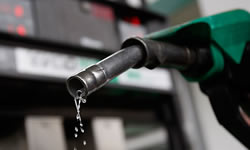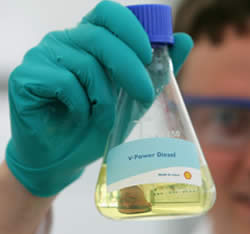Difference between Petrol and Diesel
Key Difference: Petrol, also known as Gasoline, is a transparent fuel derived from crude oil and is used as fuel in internal combustion engines. Petrol is separated from crude oil from 40°C to 205°C. Diesel is a liquid fuel that is used in diesel engines. It is commonly derived from crude oil. Petroleum diesel or petrodiesel is produced by distilling crude oil between 200 °C (392 °F) and 350 °C (662 °F) at atmospheric pressure.
 Petrol and diesel are two types of common fuels that are used to power vehicles. The debate between petrol and diesel regarding which one is the better fuel or which is more economically safe has been going on for years. Originally, diesel was considered as the worst of the two; but with the advancement in technology diesel has now becoming a cheaper and efficient choice of fuel for powering cars. However, the choice between petrol and diesel depends on the user and his usage.
Petrol and diesel are two types of common fuels that are used to power vehicles. The debate between petrol and diesel regarding which one is the better fuel or which is more economically safe has been going on for years. Originally, diesel was considered as the worst of the two; but with the advancement in technology diesel has now becoming a cheaper and efficient choice of fuel for powering cars. However, the choice between petrol and diesel depends on the user and his usage.
The process of creating petrol or diesel includes drilling for crude oil. The oil drilled from the ground is then sent to a refiner. At the refinery, heat is used to separate out different products at boiling points. The oil is then sent through a distillation process where it is applied with heat and pressure causing a chemical reaction. The application of heat and pressure determines if the product becomes petrol or diesel. Following distillation, the fuel is blended with additives that help improve the quality of the fuel. The crude oil is composed of various hydrocarbons that differ in composition. These different hydrocarbons are what make the different products that are derived from the oil. Simple hydrocarbons such as CH4, C2H6, C3H8, and C4H10 are light gases and are used in solvents for paints. The other longer chains of hydrocarbons are used to create fuel.
Petrol, also known as Gasoline, is a transparent fuel derived from crude oil and is used as fuel in internal combustion engines. The term petrol is used to refer to the fuel in UK, India, Republic of Ireland and many other places, while it is known as gas in US and Canada. Petrol is made by distilling crude oil at a certain temperature. Petrol is made from the longer hydrocarbon chains found in crude oil: C5 to C12. The C5 to C12 hydrocarbon chains are liquid at room temperature and are blended to create petrol. Petrol contains a mixture of paraffins, napthenes, aromatics and olefins. Petrol is separated from crude oil from 40°C to 205°C. Gasoline has a high volatile rate, which is controlled by blending it with butane. According to the US Environment Protection Agency (EPA), “Gasoline blends differ, and therefore actual energy content varies according to the season and producer by up to 4% more or less than the average.”
 Diesel is a liquid fuel that is used in diesel engines. It is commonly derived from crude oil, but there are also alternatives that are not derived from distilling petroleum fuel oil; these are known as biodiesel, biomass to liquid (BTL) diesel and gas to liquid (GTL) diesel. The name of the fuel is derived from the name of German inventor Rudolf Diesel who created the compression-ignition engine. Petroleum diesel or petrodiesel is produced by distilling crude oil between 200 °C (392 °F) and 350 °C (662 °F) at atmospheric pressure. Diesel has a mix of carbon chains between 8 and 21 carbon atoms per molecule. Diesel fuel quality is measured by its Cetane number. A higher cetane number indicates that the fuel ignites more readily when sprayed into hot compressed air. Diesel has a disadvantage in the winter as a vehicle fuel because of its viscosity (ability to flow). The viscosity of diesel increases as the temperature decreases and the fuel requires a special fuel pump for pumping the fuel.
Diesel is a liquid fuel that is used in diesel engines. It is commonly derived from crude oil, but there are also alternatives that are not derived from distilling petroleum fuel oil; these are known as biodiesel, biomass to liquid (BTL) diesel and gas to liquid (GTL) diesel. The name of the fuel is derived from the name of German inventor Rudolf Diesel who created the compression-ignition engine. Petroleum diesel or petrodiesel is produced by distilling crude oil between 200 °C (392 °F) and 350 °C (662 °F) at atmospheric pressure. Diesel has a mix of carbon chains between 8 and 21 carbon atoms per molecule. Diesel fuel quality is measured by its Cetane number. A higher cetane number indicates that the fuel ignites more readily when sprayed into hot compressed air. Diesel has a disadvantage in the winter as a vehicle fuel because of its viscosity (ability to flow). The viscosity of diesel increases as the temperature decreases and the fuel requires a special fuel pump for pumping the fuel.
The major difference between petrol and diesel is how it runs and performs. Diesel provides better fuel economy than petrol engines. Diesel also produces less greenhouse gas emission but has a high level of Suspended Particulate Matter (SPM) that can harm the lungs. Whether to purchase a petrol or a diesel car, it depends on the usage of the driver. If the driver has a large vehicle that has a high consumption, diesel is a better choice, while if a person has a small car and only requires it for short distance usage a petrol car works the best.
|
|
Petrol |
Diesel |
|
Made from |
Petroleum/ Crude oil |
Petroleum/ Crude oil |
|
Energy content |
38.6 MJ/liter |
34.6 MJ/liter |
|
Process |
Fractional distillation |
Fractional distillation |
|
CO2 produced per kg |
2.3 kg |
2.65 kg |
|
Calorific Value (megajoules per kilogram) |
45.8 MJ/kg |
45.5 MJ/kg |
|
Boiling Range |
40°C to 205°C |
250°C to 350°C |
|
Torque (for 10L engine) |
1000 Nm @ 2000 rpm |
300Nm @ 4000 rpm |
|
Power (for 10L engine) |
490Hp @ 3500 rpm |
600Hp @ 5500 rpm |
|
Energy by Volume |
33.7 MJ/liter |
36.9 MJ/liter |
|
Best suited for which type of car |
Small, compact cars that has low consumption |
Large cars, 4WDs and cars with high consumption |
|
Fuel economy |
Lower fuel economy |
Better fuel economy |
|
Purchase Price |
Expensive |
Cheaper |
|
Environmental impact |
High levels of CO2 and carbon monoxide (CO); initially low levels of NOx but can increase; high levels of hydrocarbon and does not produce Suspended Particulate Matter |
Low level of CO2 per kilometer; does not produce CO, high level of NOx; low level of hydrocarbon; and high level of Suspended Particulate Matter |
|
Power |
Runs at higher RPM |
More torque at low speeds |
|
Viscosity |
No change |
Increase at lower temperatures |
|
Density |
Ranges between 0.71–0.77 kg/l (6.073 lb/US gal) |
0.832 kg/l (6.943 lb/US gal) |
Image Courtesy: guardian.co.uk, howstuffworks.com









Add new comment